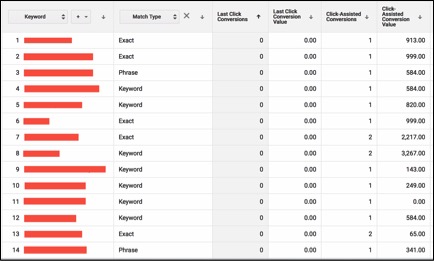Recently, I performed optimizations on an account focused on improving ROI. This particular client was highly ROI-focused and wanted me to ensure that there were no inefficiencies within the account. An inefficient keyword was defined as any keyword that wasn’t generating a certain level of profit for the company.
To start, I carefully went through the account and looked at keywords with significant spend that hadn’t provided any sales in the past three months. Assuming that they were inefficient, I lowered bids and even paused some of them. The theory being that by eliminating all of the keywords that weren’t providing sales, I’d be making the campaign more efficient and attain a higher ROI. What actually happened was a different story.
The Expectation: The campaigns that were generating sales prior to this optimization will continue to generate sales. However, ROI will be higher, due to the elimination of inefficient spend.
The Reality: Sales volume suddenly dropped.
Naturally, I began an investigation into the drop in sales. On the surface, the issue was unclear. All of the keywords that had previously been revenue generators were still in the account in the same positions as the previous week. Bids looked the same. Spend looked the same. So what could the problem be? That’s when I started digging deeper into the account. My answer was suddenly crystal clear. We had been ignoring the obvious all along – assisted conversions.
Before I continue my story, I want to take a moment to explain assisted conversions. Assisted conversions recognize the fact that sometimes the keyword on which your ad converted isn’t solely responsible for that conversion. Imagine shopping for a dress in the offline world. Perhaps you visit one store and see a dress you like, but it’s not on sale. So you continue your search and visit a different store, but they don’t have your size in stock. So you visit a third store and find the dress in your size and on sale. Even though you made your purchase at the third store, the other two stores assisted in that sale. The first store is where you discovered the dress. The other two stores were part of your effort to find that dress at the right price and size.
The same holds true for the online world. When you shop online, do you frequently purchase from the first site you visit? Probably not. If you’re anything like me, you most likely conduct several searches to make sure that you’re getting that product at the best possible price. You’re probably typing in a variety of keywords that are all related to that product to ensure that you’ve done enough research before placing that online order. You’re probably reading reviews and searching for online discounts as well. All of those searches and ad clicks before making that purchase are assisting in the process. If you didn’t read that great review about the product, you might not have made the purchase. Or, if you didn’t find that online coupon code, the sale might not have happened.
Back to the client. After pulling assisted conversion data, it became obvious that many of the keywords that appeared to be great converters were actually being helped along in the process by other keywords within the account. Without doing the research, I never would have known this, as the AdWords interface is only giving credit to the last click converters (when the Search Funnels metrics aren’t added as columns). The reality was that these great converters couldn’t stand on their own without the help of other keywords in the account. And once I removed those keywords, I removed the sales volume. It was a great lesson learned and a metric that will never be overlooked again.
Let’s walk through this analysis together. To start, your assisted conversions are located in AdWords under the Tools menu. Choose “Conversions” and you’ll then see the following menu:

Click on “Assisted Conversions” and make sure you have the proper date range selected. You may want to sort your data to show your lowest “Last Click Conversions” first, so that you can quickly identify the words that appear to be poor converters on the front end, but that actually assist with conversions on the backend. This was perhaps the most illuminating piece of data that I looked at in this analysis because it quickly showed that more than a few words were assisting with conversions. Perhaps even more enlightening was the “Click-Assisted Conversion Value” column. That was all revenue that we would have been leaving on the table, had this analysis not been performed.

Now, you certainly don’t need to look at this report on such a granular level. This data is also available on a campaign, ad group, and match type level. Choose whichever level makes the most sense for your client and start analyzing. Once I understood which keywords were assisting in the conversion process, I was able to keep them as part of the campaign and monitor them closely to ensure that they continued to assist in the conversion process as time went on. From this report, I was also able to confirm which keywords weren’t contributing and could then make informed decisions.
Final Thoughts
Will you always find this much actionable data in this report? Probably not. Each client and account is unique and their users are different as well. I work with some lead generation clients that typically get the majority of their conversions from just one click. You may also find that ecommerce clients see more assisted conversions because people tend to perform more research when they are making a purchase, as they want to ensure that they are getting the best deal possible.
Regardless of what type of client you are managing, take the time to look at this important metric. It can unlock a wealth of information and can “assist” you in making smart decisions about account management and optimization.



